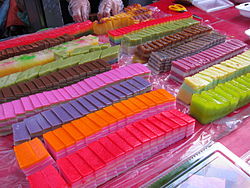Kuih

Colourful nyonya kuih in Malaysia
|
|
| Alternative names | Kueh (Hokkien), Kue (Indonesia) |
|---|---|
| Course | Snack |
| Place of origin | Malaysia, Indonesia and Singapore |
| Main ingredients | Various traditional snacks |
| |
|
Kuih (also spelled Hokkien and Teochew: kueh or kway; from the Hokkien: 粿 koé, Indonesian: kue) are bite-sized snack or dessert foods commonly found in Taiwan, Malaysia, Singapore, Indonesia (where it is called kue), and Thailand (especially Phuket and Phang-nga), the southern China provinces of Fujian and Chaoshan, and in the Netherlands through its colonial link to Indonesia. Kuih is a fairly broad term which may include items that would be called cakes, cookies, dumplings, pudding, biscuits, or pastries in English and are usually made from rice or glutinous rice. The term kueh or kuih is widely used in Indonesia, Malaysia and Singapore to refer to sweet or savoury desserts.
Kuih are more often steamed than baked, and are thus very different in texture, flavour and appearance from Western cakes or puff pastries. Many kuih are sweet, but some are savoury. It is hard to distinguish between kuih of Malay or Peranakan (also known as "Straits Chinese" people) origin because the histories of these recipes have not been well-documented. Cross-cultural influencing is also very common.
Though called by other names, one is likely to find various similar versions of kuih in neighbouring countries, such as Vietnam, Thailand, and Burma. For example, the colourful steamed kue lapis and the rich kuih bingka ubi are also available in Burma, Thailand, and Vietnam.
...
Wikipedia
